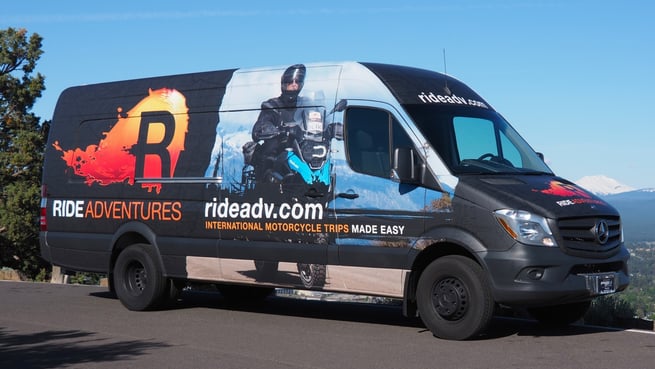 As the Mercedes Sprinter van gains popularity in the motorcycle world and now Ford, Ram, and others are making similar headway into this “toy hauler” market, weekend warriors around the world are stuck wondering “what’s the best way to make electrical power available from my van?”
As the Mercedes Sprinter van gains popularity in the motorcycle world and now Ford, Ram, and others are making similar headway into this “toy hauler” market, weekend warriors around the world are stuck wondering “what’s the best way to make electrical power available from my van?”
While it’s a bit outside our normal blog topics, which are entirely about motorcycles, motorcycle trips, etc., we thought it important enough to share with you just how easy, affordable, efficient, useful and powerful the sun can be in this article.
The motivation behind this project was simple: We need electrical power at the motorcycle rallies, races, and events that we’ve been meeting you at. Running a nice big flat screen TV to show our tour videos and photos, charging our laptops & cell phones, and even charging your cell phones (glad to!) is an ever-present need at these events. The challenge of course, is that a “plug-in” power source is not always available at motorcycle events, as we are often out in parking lots, open fields, etc. where there is no electrical outlet. In other words: “How could we come up with an electrical power source sufficient for our needs, and one that can be used when completely 'off the grid?'"
 After extensive research on this subject and looking at the options for getting this power, we’ve installed rigid solar panels and a 450ah battery bank in our 2014 Mercedes Sprinter van. (For the record, this is a cargo version of the 3500 van, 170” Extended, with the V6 Turbo Diesel.) This article will continue to explain just how we went about it, the thought process, purchasing, installation, etc. and hopefully help you make the right decision for your needs.
After extensive research on this subject and looking at the options for getting this power, we’ve installed rigid solar panels and a 450ah battery bank in our 2014 Mercedes Sprinter van. (For the record, this is a cargo version of the 3500 van, 170” Extended, with the V6 Turbo Diesel.) This article will continue to explain just how we went about it, the thought process, purchasing, installation, etc. and hopefully help you make the right decision for your needs.
Before explaining how we found and installed the solar panel solution though, it’s important to first mention the 2 other options that were considered, but in the end "passed on" for clear reasons:
A Gasoline-Powered Generator - A simple gasoline-powered pull-start generator can provide a lot of power, but at an unfortunate cost and hassle. Sure, good gasoline generators are made to be very quiet now, but the task of filling up its fuel tank, making sure to have extra fuel handy, unloading and setting up the generator, putting it away, being concerned about theft or damage if it’s left outside the vehicle…were all too much of a hassle to really be attractive. – Furthermore, if a generator was being used to simply “replenish” an existing battery or batteries that are installed in the vehicle, it wouldn’t even be the best solution for “tending” to the needs of batteries in the first place. Generators don’t taper-off their charging rate as a battery nears fully-charged status, so the result can be over-charging the batteries, and therefore shortening their life expectancy and overall performance.
A Diesel-Powered Generator – We never landed on firm pricing for “how much” it would cost to have a diesel generator installed beneath the chassis of the Sprinter, but indications were that it’d be between $4,000 and $7,000. (As a side note, apparently this would also mean we have to eliminate the spare tire that’s mounted beneath the Sprinter, potentially putting us in a difficult roadside situation someday.) While a diesel generator would have a major advantage over the gasoline generator, in that we could use the diesel fuel already in the Sprinter, it just doesn’t make sense to us when you look at the downsides to this idea. The cost of a diesel generator, the thought of having to use more fuel (create more emissions), have more moving parts (possible engine failures) and destroying the precious, seldom-experienced joy of “silence” by running and listening to a diesel engine, make the idea of a diesel generator very, very unattractive.
SO, without a plug-in electrical source, and without a gasoline or diesel-powered generator on board, as mentioned before, the most beautiful, quiet, clean electrical power option available on the planet became the obvious choice for our power needs: We decided to just use the sun!
Specifically, we’ve installed a solar panel solution provided by SolarDealz.com on the roof of our Sprinter van. Those panels now feed a “battery bank” that is safely and discretely stored below the chassis, out of the way yet still completely useful. Now that our decision to “go solar” is clear, the rest of this article will show the steps we followed to arrive at this fantastic outcome, and hopefully encourage you to do the same.
(Part 2 of this solar panel installation project is on the way, so you can subscribe to our blog on the top-right of this page, and signup for our eNewsletter here.)


